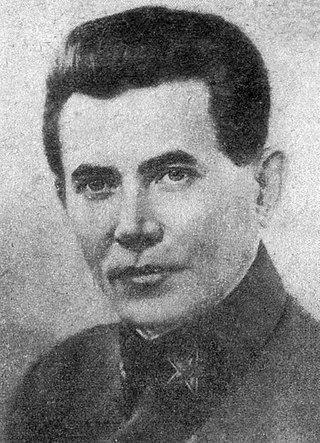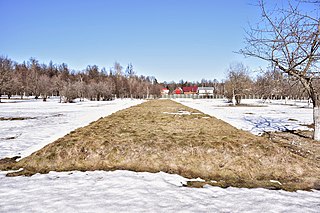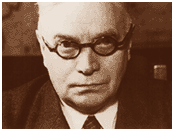
The Great Purge or the Great Terror, also known as the Year of '37 and the Yezhovshina, was Soviet General Secretary Joseph Stalin's campaign to solidify his power over the Communist Party of the Soviet Union and the state, by removal and execution of people; the purges were also designed to remove the remaining influence of Leon Trotsky as well as other prominent political rivals within the party. It occurred from August 1936 to March 1938.

Nikolai Ivanovich Yezhov was a Soviet secret police official under Joseph Stalin who was head of the NKVD from 1936 to 1938, during the height of the Great Purge. Yezhov organized mass arrests, torture and executions during the Great Purge, but he fell from Stalin's favour and was arrested, subsequently admitting in a confession to a range of anti-Soviet activity including "unfounded arrests" during the Purge. He was executed in 1940 along with others who were blamed for the Purge.
NKVD troika or Special troika, in Soviet history, were the People's Commissariat of Internal Affairs made up of three officials who issued sentences to people after simplified, speedy investigations and without a public trial. The three members were judge and jury, though they themselves did not carry out the sentences they dealt. These commissions were employed as instruments of extrajudicial punishment introduced to supplement the Soviet legal system with a means for quick and secret execution or imprisonment. It began as an institution of the Cheka, then later became prominent again in the NKVD, when it was used during the Great Purge to execute many hundreds of thousands of Soviet citizens. Defendants in the Troika's proceeding were typically not entitled to legal aid or the presumption of innocence. Convictions usually did not include information about the actual incriminating evidence and basically contained only information about indictment and sentencing. The outcome of such trials was often determined before it even began due to targeted numbers of citizens to be executed or imprisoned in Gulag prison camps.
The Polish Operation of the NKVD in 1937–1938 was an anti-Polish mass-ethnic cleansing operation of the NKVD carried out in the Soviet Union against Poles during the period of the Great Purge. It was ordered by the Politburo of the Communist Party against so-called "Polish spies" and customarily interpreted by NKVD officials as relating to 'absolutely all Poles'. It resulted in the sentencing of 139,835 people, and summary executions of 111,091 Poles living in or near the Soviet Union. The operation was implemented according to NKVD Order No. 00485 signed by Nikolai Yezhov.

NKVD Order No. 00447 of July 30, 1937 was signed by Nikolai Yezhov and approved by the Politburo during the Great Purge.
Mass operations of the People's Comissariate of Internal Affairs (NKVD) were carried out during the Great Purge and targeted specific categories of people. As a rule, they were carried out according to the corresponding order of the People's Commissar of Internal Affairs Nikolai Yezhov.

Mikhail Petrovich Frinovsky was a Soviet secret police official who served as a deputy head of the NKVD under Nikolai Yezhov during the Great Purge.

Johannes Baptist "Hans" Beimler was a trade unionist, Communist Party official, deputy in the 1933 Reichstag, an outspoken opponent of the Nazis and a volunteer in the international brigades fighting for the Spanish Republic.

The Butovo Firing Range or Butovo Shooting Range was an execution site of the Soviet secret police located near Drozhzhino in Leninsky District, Moscow Oblast from 1938 to 1953. Its use for mass execution has been documented; it was prepared as a site for mass burial. As the late Arseny Roginsky explained: "firing range" was a popular euphemism adopted to describe the mysterious and closely-guarded plots of land that the NKVD began to set aside for mass burials on the eve of the Great Terror.

Willi (Willy) Lehmann was a police official and Soviet agent in Nazi Germany.
The Karl Liebknecht School, named after Karl Liebknecht, was a German-language elementary school in Moscow. It was established for the children of German refugees to the Soviet Union. It opened in 1924 and was closed in 1939. A number of students and teachers were caught up in the Great Purge and the so-called Hitler Youth Conspiracy, many of them executed.

Gustav Sobottka was a German politician in East Germany. He was a member of the Communist Party and was in exile during the Nazi era. He returned to Germany in 1945 as head of the Sobottka Group and later worked in the East German government.
The Left Column was an agitprop theater troupe during the 1920s and 1930s. The troupe worked in support of the Workers International Relief (WIR). During the Nazi era, some of the group went into exile in the Soviet Union, where some of the members were arrested by the Soviet secret police in the Great Purge and in connection with the Hitler Youth Conspiracy.

Helmut Damerius was a German communist, theatre director, writer and the founding member of the Left Column, an agitprop theater group. As the Nazi Party gained in strength, he went into exile in Moscow, only to be arrested in the so-called Hitler Youth Conspiracy and sentenced to a long term in a Soviet prison. After his prison sentence, he was banished to Kazakhstan and was not permitted to move elsewhere. In 1956, he received permission to move to East Germany, where he stayed until his death.
Gustav Sobottka Jr. was a German communist and the son of Communist Party functionary and trade unionist Gustav Sobottka. He spent several months in Nazi concentration camps, then left Germany, eventually living in exile in the Soviet Union. He was arrested by the Soviet secret police at the age of 23 and accused of being part of the so-called Hitler Youth Conspiracy. Sobottka died in a Soviet prison.

The Deutsche Zentral-Zeitung was the German-language newspaper published in Moscow by the German-speaking section of the Communist International. The newspaper's type was set in Fraktur and contained translations of Russian articles and speeches, reviews, articles from and about other countries, and it publicized pronouncements and information from the Communist Party. Published for little over a decade, the newspaper ceased publication in 1939 after Soviet secret police (NKVD) arrested so many of the staff that it no longer had enough people to continue operation. The newspaper remained without a successor until 1957.
The Moscow trials were a series of show trials held by the Soviet Union between 1936 and 1938 at the instigation of Joseph Stalin. They were nominally directed against "Trotskyists" and members of "Right Opposition" of the Communist Party of the Soviet Union. At the time the three Moscow trials were given extravagant titles:
- The "Case of the Trotskyite–Zinovievite Terrorist Center" ;
- The "Case of the Anti-Soviet Trotskyist Center" ; and
- The "Case of the Anti-Soviet 'Bloc of Rightists and Trotskyites'".

The People's Commissariat for Internal Affairs, abbreviated NKVD, was the interior ministry of the Soviet Union.

The Latvian Operation was a national operation of the NKVD against ethnic Latvians, Latvian nationals and persons otherwise affiliated with Latvia and/or Latvians in the Soviet Union from 1937 to 1938 during the period of the Great Purge.












